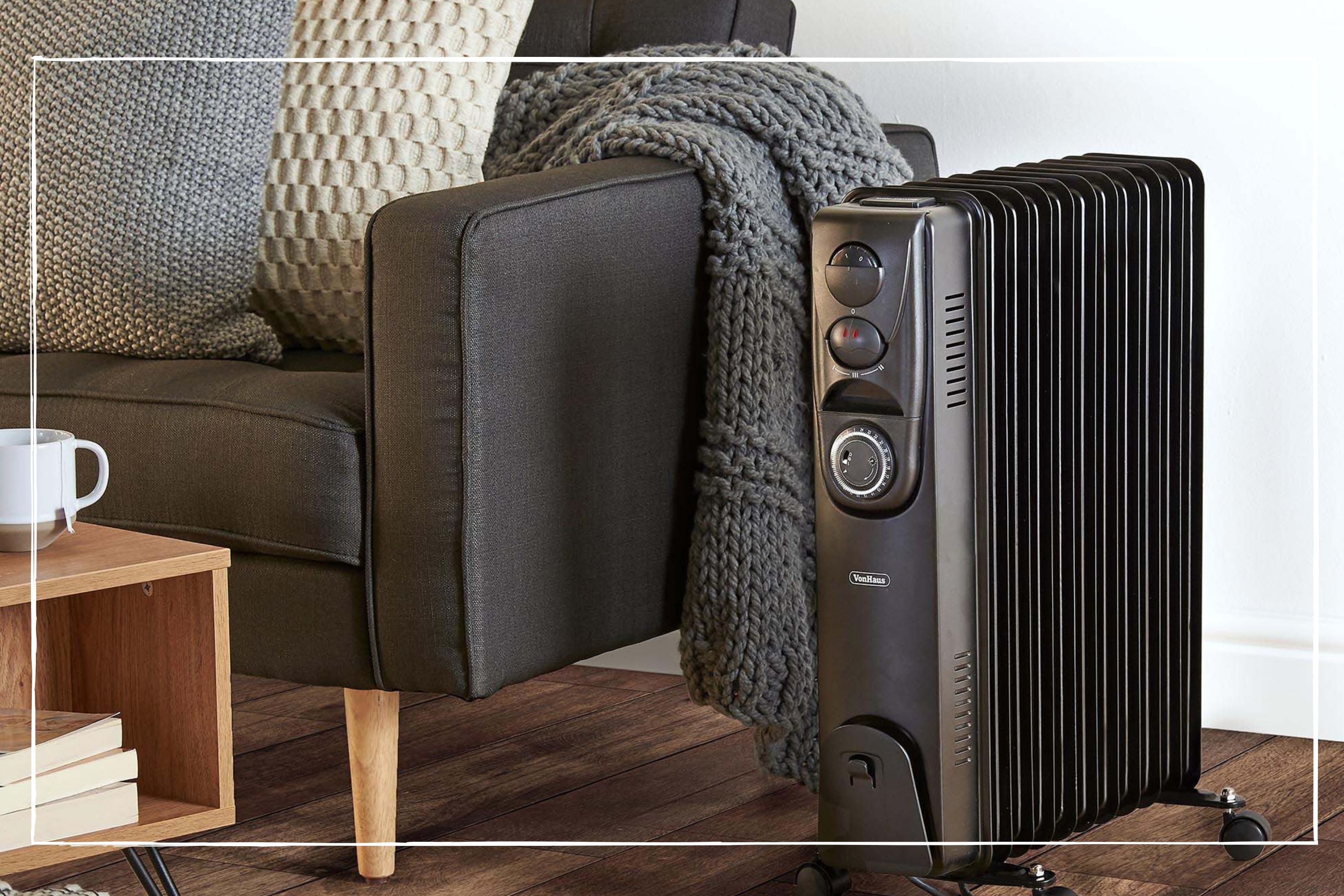How much does it cost to run an indoor heater at home?
If you’re wondering how much does it cost to run an indoor heater at home, we’ve done the calculations…


Sarah Handley
Recent updates
The costs in this article have been updated to reflect the October 2023 energy price cap figures.
How much does it cost to run an indoor heater and is it a cost-effective way to stay warm? These are important questions to ask right now as families continue to worry about how much their energy bills will cost as energy prices remain high.
Despite the energy price cap dropping in October, struggling families are continuing to learn how to save energy at home to keep costs down. As a result, you might be thinking about using an indoor heater instead of whacking up the thermostat.
Goodto.com's Money Editor Sarah Handley says: "Millions of families will be worried about the cost of staying warm this winter so it helps to understand exactly how much different heating options cost to run so you can make sure you opt for the cheapest yet most effective option in order to keep your energy bills as low as they can be."
How much does it cost to run an indoor heater?
It costs around 54p an hour to run a typical 2kW indoor heater. If you used your heater for four hours a day, that would cost you £2.16 per day, or £65.66 per month. Assuming you ran your heater daily for four months of the year, your overall annual cost would be £262.64.
However, exact running costs will depend on the type of heater you’re using, how frequently you use it, and how much you pay for your energy. The price you pay per kWh of electricity changed on 1 October when the energy price cap dropped. This means households now pay 27p per kWh for electricity they use. Before October, households paid 30p for each kWh of electricity used.
Types of indoor heater
There are four main types of indoor heater that use electricity:
- Halogen heaters - lightweight and portable, these use halogen elements rather than electrical coils to provide heat. Heat outputs typically range from 0.5kW to 2kW
- Fan heaters - easily portable, these work by running a current through a heating coil. Air is drawn over the heated coil and the warm air is blown out into the room. Heat outputs typically range from 0.5kW to 3kW
- Oil filled radiators - these work by using an electrical element to heat a reservoir of thermal oil inside. Heat outputs can be between 1kW and 3kW
- Convector heaters - these use a heating coil that produces hot air and the air is then distributed into the room. Heat outputs can be between 2kW and 3kW.
For comparison, we’ve looked at the four different heater types and used different power outputs for each to give you an idea of different running costs. In each example, we’ve assumed the heater will be used for four hours a day for four months of the year.
GoodtoKnow Newsletter
Parenting advice, hot topics, best buys and family finance tips delivered straight to your inbox.
| Header Cell - Column 0 | Cost per hour | Cost per day | Cost per month | Cost per year |
|---|---|---|---|---|
| 1.2kW halogen heater | 32.4p | £1.30 | £39.40 | £157.59 |
| 1.5kW fan heater | 40.5p | £1.62 | £49.25 | £196.99 |
| 2.5kW oil filled radiator | 67.5p | £2.70 | £82.08 | £328.32 |
| 3kW convector heater | 81p | £3.24 | £98.50 | £393.98 |
How much do your other appliances cost to run?
- How much does it cost to boil a kettle?
- How much does it cost to run an air fryer?
- How much does it cost to run a microwave?
- How much does it cost to run a washing machine?
- How much does it cost to run a slow cooker?
- How much does it cost to run a dishwasher?
- How much does a tumble dryer cost to run?
- How much does it cost to run an heated clothes dryer?
- How much does it cost to run a dehumidifier?
- How much electricity does a TV use?
You can also use our comparison tool to compare how much your appliances cost to run:
Which type of indoor heater is cheapest to run?
The type of indoor heater that’s cheapest to run will ultimately depend on how powerful it is and how often you use it. All wattages and run time being even, halogen, fan, oil filled, and convector heaters will cost the same to run.
However, Ryan Collier, director of Heat Pump Source, adds: “Generally, halogen heaters can be the cheapest to run due to their lower power output and the fact they can be used intermittently for blasts of heat.
“For longer periods, oil filled radiators are considered one of the most energy efficient types of heaters. Once they're at the desired temperature, they use low power to maintain the warmth. Compared to other heaters, they also retain heat better, so they will still radiate heat for a while after you've switched them off.”
How can I cut the cost of running an indoor heater?
Below are some tips to help you cut the cost of running your indoor heater:
Use your heater wisely
Carefully consider where in the home you want to use your indoor heater. If it’s an open-plan room or one with high ceilings, it’ll cost you a lot more to heat the room to the desired temperature.
Jennifer Warren, spokesperson for Energy Guide UK, explains: “Electric heating should only be used for limited periods of time and to heat a small space, for example, a single room and for an hour or two.”
Make sure you keep windows and door closed while the heater is in use to keep the warmth you are creating in, rather than letting it escape into other rooms or out the window.
Find out more about the cheapest way to heat a room.
Set a timer or use a thermostat
Using an indoor heater that comes with a timer or thermostat can also help reduce costs. This will enable you to regulate the power output and how long the heater is switched on for, saving you money.
If you have a heater without a timer, you can add a smart plug to enable you to decide when the heater needs to be on and off.
Get insulated
A quarter of heat is lost through the roof of an uninsulated home, and a third is lost through the walls, according to the Energy Saving Trust. To stop hot air escaping and reduce the length of time you need your heater to be on, block draughts around doors and windows and hang thicker curtains.
It could also be worth investing in better loft insulation as well as cavity wall insulation if you don't already have it.
What features should you look for when buying an indoor heater?
Different types of heaters are better for different purposes, so you'll need to consider what best matches your needs.
Heating expert Ryan Collier advises: “If you want instant heat, go for a halogen heater. Convector heaters are good for heating up small to medium rooms evenly. Oil-filled radiators give long-lasting heat, and fan heaters can warm up a room quickly.”
Once you know which type of heater you would like, you need to consider the wattage. “The wattage tells you how much power the heater uses and is a good indicator of how powerful the heater will be. You will want to choose a heater with a wattage that suits the room's size. As a general rule of thumb, you want 60-70 watts per square metre,” says Ryan Collier.
Another great feature to have is a variable heat option. “This is so you can change the amount of heating depending on whether it is a warmer or colder day,” explains Paul Gibbens, marketing manager at housebuyers4u. This will prevent you from generating more heat than you need, and therefore save you money.
Finally, remember it’s best to buy a heater with a built-in thermostat and/or timer that can be controlled automatically. Energy Guide’s Jennifer Warren told us: “This will ensure you limit its use to just a few hours and don't forget about it and risk leaving it on all day, which can soon add up. In addition, safety mechanisms such as automatic cut-off features are useful as these will automatically turn the heater off if it falls over.”
You might also be interested in our article on how many hours a day should heating be on in the UK.

Mum of two, Rachel is a freelance personal finance journalist who has been writing about everything from mortgages to car insurance for over a decade. Having previously worked at Shares Magazine, where she specialised in small-cap stocks, Rachel developed a passion for consumer finance and saving money when she moved to lovemoney.com. She later spent more than 8 years as an editor at price comparison site MoneySuperMarket, often acting as spokesperson. Rachel went freelance in 2020, just as the pandemic hit, and has since written for numerous websites and national newspapers, including The Mail on Sunday, The Observer, The Sun and Forbes. She is passionate about helping families become more confident with their finances, giving them the tools they need to take control of their money and make savings. In her spare time, Rachel is a keen traveller and baker.
- Sarah HandleyMoney Editor, GoodtoKnow
-
 How to save money: 28 family-friendly money-saving tips for mums and dads
How to save money: 28 family-friendly money-saving tips for mums and dadsUnderstanding how to save money is key to limiting the impact of rising costs as much as possible
By Sarah Handley Published
-
 14 hidden benefits of your Amazon Prime membership
14 hidden benefits of your Amazon Prime membershipWe reveal the less-obvious perks of a Prime membership that will help you get the most value out of your subscription fee
By Rachel Wait Published
-
 14 surprising ways to spend your Tesco Clubcard vouchers - from restaurants and cinema passes to mini breaks and Disney+
14 surprising ways to spend your Tesco Clubcard vouchers - from restaurants and cinema passes to mini breaks and Disney+Tesco Clubcard vouchers can help you cut the cost of everything from groceries and travel to days out and cinema tickets
By Heidi Scrimgeour Published
-
 How to get Disney+ for free and save up to £79.90 a year
How to get Disney+ for free and save up to £79.90 a yearEven though the streaming giant ended its free trial offering, there are still multiple ways you can get Disney+ for free for up to 12 months
By Sarah Handley Published
-
 Parents of teens who have just taken their GCSEs urged to check child benefit status ahead of August deadline
Parents of teens who have just taken their GCSEs urged to check child benefit status ahead of August deadlineWith a child benefit deadline looming, some parents could see their payments reduced or stopped altogether - here's why
By Sarah Handley Published
-
 Parents should hold off buying this back to school staple 'as close to their first day as possible', says retailer
Parents should hold off buying this back to school staple 'as close to their first day as possible', says retailerWith parents turning their attention to kitting their kids out for the new school year, research suggestions which items should be left until the last minute
By Sarah Handley Published
-
 7 ways to save on back to school essentials, as its revealed parents will spend £2.3 billion in 2024
7 ways to save on back to school essentials, as its revealed parents will spend £2.3 billion in 2024We share ways you can get your child all the bits and bobs they need for the new school year, without breaking the bank
By Sarah Handley Published
-
 What day is child benefit paid around the bank holiday? Everything parents need to know
What day is child benefit paid around the bank holiday? Everything parents need to knowKnowing which day child benefit is paid when it comes to the bank holiday can help families plan their budgets accordingly
By Sarah Handley Published